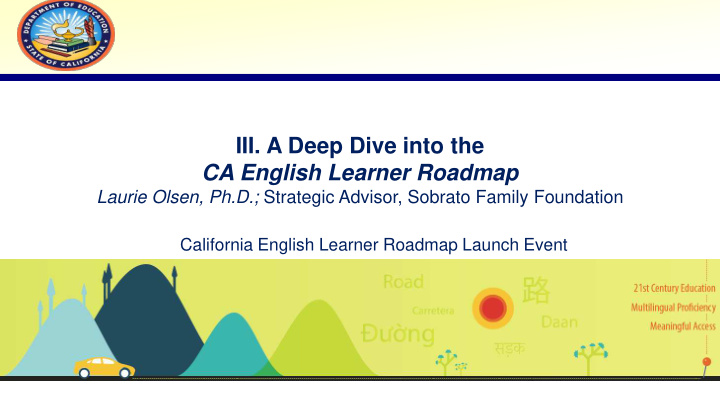



III. A Deep Dive into the CA English Learner Roadmap Laurie Olsen, Ph.D.; Strategic Advisor, Sobrato Family Foundation California English Learner Roadmap Launch Event
At Your Tables: • Have you heard about the CA EL Roadmap ? Where and from whom? • What have you heard? • What has been the “tone” and message? 2
CA EL Roadmap Infographic 3
A Close Reading of the CA EL Roadmap Policy Page 2 • What seems important here? • What seems new ? –How is this a new direction for EL policy? For EL practices? • Which words, phrases, or key concepts jump out at you? 4
Vision Page 2 English learners fully and meaningfully access and participate in a twenty-first century education from early childhood through grade twelve that results in their attaining high levels of English proficiency, mastery of grade level standards, and opportunities to develop proficiency in multiple languages. Page 1 5
Mission Page 2 California schools affirm, welcome and respond to a diverse range of English learner strengths, needs and identities. California schools prepare graduates with the linguistic, academic and social skills and competencies they require for college, career and civic participation in a global, diverse and multilingual world, thus ensuring a thriving future for California. Page 1 6
How Is This Different? A Table Activity • Reflect on the mission and vision of Fill in the T-Graph (in your Deep Dive tab) depicting the shift: the CA EL Roadmap Policy. • Discuss with your table the shift that the new policy represents from previous policy. • What is new and different about this policy from the previous? 7
Four Interrelated Principles • Research-based • Intended to guide all levels of the system towards a coherent, aligned set of practices, services, relationships, and approaches • Shared responsibility of all educators 8
The Four Principles Video 9
Principle One: Assets-Oriented and Needs-Responsive Schools Pre-schools and schools are responsive to different English learner strengths, needs, and identities and support the socio-emotional health and development of English learners. Programs value and build upon the cultural and linguistic assets students bring to their education in safe and affirming school climates. Educators value and build strong family, community, and school partnerships. Pages 13–14 10
Principle Two: Intellectual Quality of Instruction and Meaningful Access English learners engage in intellectually rich, developmentally appropriate learning experiences that foster high levels of English proficiency. These experiences integrate language development, literacy, and content learning as well as provide access for comprehension and participation through native language instruction and scaffolding. English learners have meaningful access to a full standards-based and relevant curriculum and the opportunity to develop proficiency in English and other languages. Pages 14–15 11
Principle Three: System Conditions that Support Effectiveness Each level of the school system (state, county, district, school, pre-school) has leaders and educators who are knowledgeable of and responsive to the strengths and needs of English learners and their communities, and who utilize valid assessment and other data systems that inform instruction and continuous improvement. Each level of the school system provides resources and tiered support to ensure strong programs and build the capacity of teachers and staff to leverage the strengths and meet the needs of English learners. Page 15 12
Principle Four: Alignment and Articulation Within and Across Systems English learners experience a coherent, articulated, and aligned set of practices and pathways across grade levels and educational segments, beginning with a strong foundation in early childhood and appropriate identification of strengths and needs, continuing through to reclassification, graduation, higher education, and career opportunities. These pathways foster the skills, language(s), literacy, and knowledge students need for college- and career-readiness and participation in a global, diverse, multilingual twenty-first century world. Pages 15–16 13
Principles to Elements 14
Count off around your table 15
Go to a Table for Your Principle Pages 2–4 Read the vision, mission, and your assigned principle and its corresponding elements. Highlight or circle key phrases and points DISCUSS • What seems new ? • What seems important ? • How is this a shift from the past and from current practices? • What does this look like and what does this mean at the classroom level? At the school level? At the district level? Use the notetaking guide to jot down key thoughts 16
Return to Your Team Page 4 • Two minutes to review and present about each principle 17
Crosscutting Themes Page 5 Themes: • Select one theme that matters to you! • Affirming • Assets-based • Using the notetaking guide, take • Inclusive notes towards your elevator speech about why the CA EL • Intellectually rich Roadmap is important • Full access • Student responsive • Bilingualism/proficiency in multiple languages • Investment in capacity and systems 18
9:15 to 10:30 a.m. BREAK 19
Recommend
More recommend